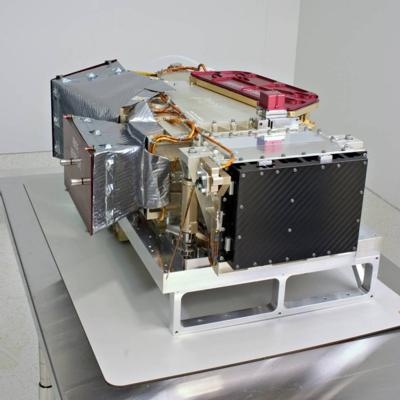Fri, Nov 23, 2012
Remote Sensing Package Will Study Why Mars Largely Lost Its Atmosphere
A remote sensing instrument that will peer into the ultraviolet to offer clues to how Mars might have lost its atmosphere has arrived at Lockheed Martin for integration into NASA's Mars Atmosphere and Volatile EvolutioN (MAVEN) spacecraft.

"The Remote Sensing package team built a system (pictured in NASA image) that meets all technical requirements and delivered it on schedule and on budget," said David Mitchell, MAVEN project manager from NASA’s Goddard Space Flight Center in Greenbelt, MD. "I look forward to the instrument’s next level of integration onto the spacecraft and ultimately the science it will provide.”
The Remote Sensing package consists of an Imaging UltraViolet Spectrograph (IUVS) and its control electronics box, the Remote Sensing Data Processing Unit (RSDPU). The Remote Sensing package was conceived, designed and built by the University of Colorado’s Laboratory for Atmospheric and Space Physics (CU/LASP) at Boulder, under contract to NASA Goddard. The Imaging UltraViolet Spectrograph collects the light and spreads it out into spectra and records the spectra using imaging detectors. IUVS is the eyes of the instrument. The Remote Sensing Data Processing Unit is the main electronics box that controls IUVS and communicates with the spacecraft. RSDPU receives and executes the commands sent to tell IUVS when and where to look. RSDPU is the brain of the instrument.
"The IUVS performs 'remote sensing,' meaning we can study the planet and its atmosphere at a distance through the light it emits," said Nick Schneider, IUVS lead scientist from CU/LASP. "Ultraviolet light is especially diagnostic of the state of the atmosphere, so our instrument provides the global context of the whole atmosphere for the local measurements made by the rest of the payload."
The Remote Sensing package will be turned on for its initial checkout 21 days after launch. Later in the cruise phase of the mission from Earth to Mars, the package will be powered on twice more for state-of-health checks and in-flight calibration. "With the delivery of this package, we are shifting from assembling the basic spacecraft to focusing on getting the science instruments onto the spacecraft," said Bruce Jakosky, MAVEN principal investigator from CU/LASP. "This is a major step toward getting us to launch and then getting the science return from the mission."
Launching late next year, MAVEN will be the first mission devoted to understanding the Martian upper atmosphere. The goal of MAVEN is to determine the history of the loss of atmospheric gases to space through time, providing answers about Mars climate evolution. By measuring the current rate of escape to space and gathering enough information about the relevant processes, scientists will be able to infer how the planet’s atmosphere evolved in time.
The MAVEN spacecraft will carry two other instrument suites. The Particles and Fields Package, built by the University of California at Berkeley Space Science Laboratory with support from University of Colorado at Boulder's Laboratory for Atmospheric and Space Physics (CU/LASP) and NASA Goddard, contains six instruments that will characterize the solar wind and the ionosphere of the planet. The Neutral Gas and Ion Mass Spectrometer, provided by NASA Goddard, will measure the composition and isotopes of neutral ions. "Three of the big milestones in an instrument builder's life are the day you get selected to fly on a mission, the day you deliver the instrument to the spacecraft to get ready for launch, and the day that it gets where it's going and data starts flowing back from space," said Mark Lankton, Remote Sensing package program manager from CU/LASP. "The Remote Sensing team is really happy to have gotten to the second milestone, and we can hardly wait to reach the third."
More News
Aviation Governance Secured...At Least For a While The National Business Aviation Association similarly applauded the passage of the FAA's recent reauthorization, contentedly recou>[...]
Emphasis On Growing The Future of Aviation Through Concentration on 'AFFORDABLE FLYERS' It's been a number of years since the Latest Edition of Jim Campbell's HUGE SportPlane Resou>[...]
Amazilia Aerospace GmbH, Develops Digital Flight Control, Flight Guidance And Vehicle Management Systems Textron eAviation has acquired substantially all the assets of Amazilia Aer>[...]
Honeywell's Primus Brings New Tools and Niceties for Hawker Operators Hawker 4000 business jet operators have a new installation on the table, now that the FAA has granted an STC f>[...]
Company Celebrates Niche-but-Important Advancement in Industry Standards Echodyne has announced full integration of its proprietary 'EchoFlight' radar into the e American Aerospace>[...]
 Bolen Gives Congress a Rare Thumbs-Up
Bolen Gives Congress a Rare Thumbs-Up The SportPlane Resource Guide RETURNS!!!!
The SportPlane Resource Guide RETURNS!!!! Buying Sprees Continue: Textron eAviation Takes On Amazilia Aerospace
Buying Sprees Continue: Textron eAviation Takes On Amazilia Aerospace Hawker 4000 Bizjets Gain Nav System, Data Link STC
Hawker 4000 Bizjets Gain Nav System, Data Link STC Echodyne Gets BVLOS Waiver for AiRanger Aircraft
Echodyne Gets BVLOS Waiver for AiRanger Aircraft



